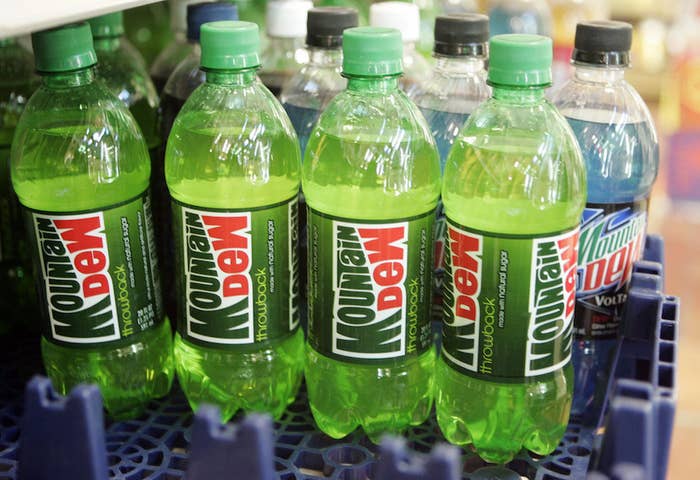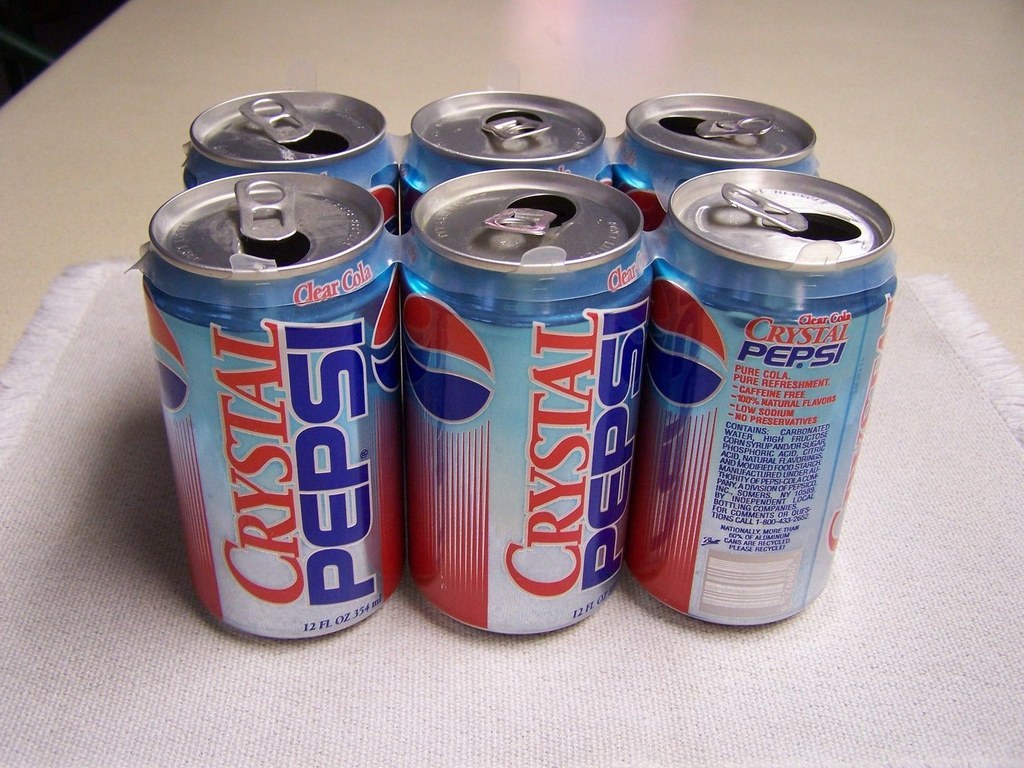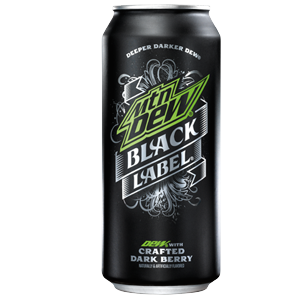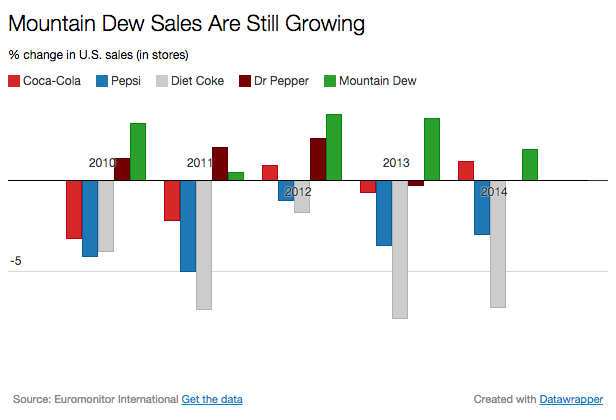
There's something about Mountain Dew that evades all definition.
Its color is boldly unnatural. It tastes, approximately, like melted Life Savers, but unlike any recognizable fruit or flavor. There are no noteworthy Mountain Dew copycats or competitors. Mountain Dew exists, largely, in its own realm, separate from other sodas — and other beverages entirely.
And that turns out to be a feature, not a bug. Thanks to its radical vagueness, Mountain Dew has managed to launch a procession of spin-off flavors, each as enigmatic as the original. (Mountain Dew Voltage, anyone? It's blue, and "charged with ginseng and raspberry citrus" flavor.) Those spin-offs have helped the brand do something none of America's other giant soda brands — Coke, Pepsi, Dr Pepper — have managed to: grow sales every year since 2010, despite a widespread sense that America is moving on from its love affair with soda.
So this ambiguous drink is a big deal. But what is Mountain Dew, when you really get down to it?
We thought asking the folks at Mountain Dew would sharpen our understanding on a matter of such great import, but the mystery surrounding America's fifth most popular soda only deepened.
"We don't try to say what color the product is internally," Greg Lyons, vice president of marketing at Mountain Dew, told BuzzFeed News. He called it "Mountain Dew color," which really didn't push things forward much. We pressed further.
"Neon," he eventually said, reluctantly.
"That's if you're forcing me to describe it. 'Mountain Dew color' is in my words. If you force me to use an adjective, that's what I'd use. But I'd prefer, if you write about it, it to be Mountain Dew color. Because there's not really a color we call it."
The official BuzzFeed style guide does not recognize "Mountain Dew" as a legitimate color, so we're going to stick with chartreuse.
@theshrillest @dreamoforgonon 7-Up is Lemon Lime. Mountain Dew tastes like "Yellow."
Like the best abstract art, Mountain Dew leaves plenty of room for interpretation. Since first launching as a whiskey mixer in Tennessee in 1940 — its name was old-timey slang for moonshine — it has successfully spawned a rainbow of spin-offs of differing colors, tastes, and fundamental natures.
The packaging and labels across the different products are not consistent. No Mountain Dew variety looks or tastes like the other, and yet no one challenges their membership in the Mountain Dew family.
Its owners see it as something that transcends the senses. Indra Nooyi, CEO of Mountain Dew owner PepsiCo, told BuzzFeed News that Mountain Dew is "an attitude. It's a fantastic attitude in a bottle." And attitude never had a particular taste, per se.
Mountain Dew is, at once, both nothing and anything.
Some Mountain Dews are yellow, some are red, some are blue. Some taste vaguely like cherry, others like berries or lime, yet their names — "Baja Blast," "SuperNova," "Code Red" — don't attempt to evoke any particular flavor. Soon, there even will be a Mountain Dew sauce at Buffalo Wild Wings.
Then there's Mountain Dew Solar Flare, currently available exclusively from the soda fountains at 7-Eleven. It describes itself as "Dew with a blast of tropical punch." None of these words are a flavor, or a taste, or even an attitude.
Seriously, WTF is going on here?

Other sodas, like colas, could never get away with such an postmodern approach.
Consider the cola. It may contain multitudes, but it's always blackish-brown, even if there's some cherry or vanilla flavoring in there. The color, and the taste, are cola traits that consumers are apparently deeply attached to.
Make a clear cola, as Pepsi did with the 1992 launch of the colorless Crystal Pepsi, and people freak out. No one could resist comparing it to the original, to the singular cola aesthetic that they didn't want adulterated. Crystal Pepsi lacked the "pronounced bouquet" of a dark cola, remarked the New York Times, and that was Not OK.
"It was hard for the consumer to think of cola being clear. Confusion hurt the brand. What was it?" said Beverage World contributing research editor Michael Bellas about Crystal Pepsi in a 1995 article, after the drink had already been abandoned.
Loyal Mountain Dew consumers, known to marketers as the "Dew Nation," would never take such a rigid approach to the drink. They are "a very loyal customer base that is open to try any and every thing we do," Lyons said.
Might the Dew Nation simply be a more advanced and accepting society?
RIP

This brings us to Mountain Dew's latest creation — Black Label.
Mountain Dew's conceptual slipperiness means the brand's latest launch comes in the form of Black Label, a purple, berry-flavored soda that also happens to contain herbal bitters. It will be sold online soon, and then in stores by spring 2016.
The average human might say Black Label Mountain Dew has absolutely nothing to do with original Mountain Dew in terms of appearance or taste. Yet since its limited launch on college campuses this fall, the company said Black Label has been wildly popular, aided by the Dew Nation.
This is Mountain Dew?


Despite the way Americans judged and rejected Crystal Pepsi for dishonoring cola, we seem more than OK with the growing array of Dews. Sales of all varieties of the brand in stores and restaurants exceeds $9 billion globally (of which $8 billion were made in the U.S.), according to the company.
As consumption declines for the big cola brands, Mountain Dew has emerged in recent years as an unlikely victor in the soda business, shows data from researcher Euromonitor International. Credit for this goes, in part, to all the new iterations that have been coming out. Lyons said one of the reasons Mountain Dew has been growing "is we've been innovating an awful lot more recently than we have in the past."

This may be beverage postmodernism, but it isn't anarchy. There are rules.
Lyons says Mountain Dew follows three "guardrails" as it develops new products.
There has to be caffeine and a bold color and flavor, and it should be citrusy (original Dew contains concentrated orange juice).
"We do have guardrails, and we're very strict, but they're not as tight or as narrow guardrails as some other brands have," he said. "As long as it delivers on what a Mountain Dew product should deliver on — and that's the physical and emotional kick — and that refreshing citrus charge, I think we're in great shape."
BuzzFeed News reporter Matt Zeitlin reflected on the situation. "Mountain Dew is an empty vessel for brand ideas," he concluded.
Perhaps another answer to our original question — what is Mountain Dew? — is this peaceful image of literal mountain dew, without the physical and emotional kick.

